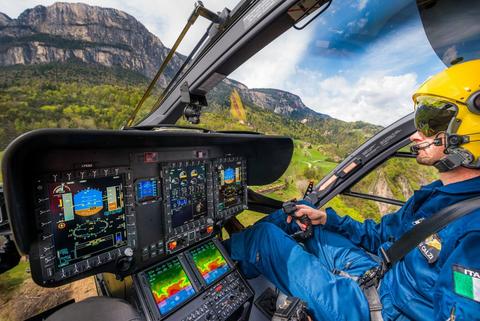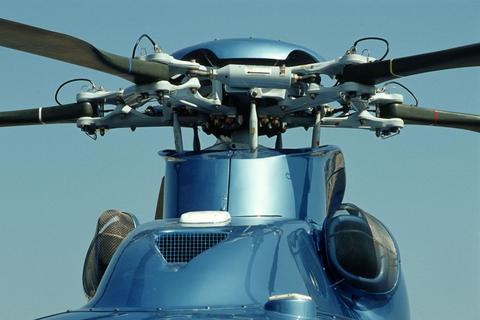The technological leadership of Airbus directly supports the safe operation of the company’s rotorcraft in missions around the world. From cutting-edge aircraft design to state-of-the-art systems and displays, Airbus has developed a reputation for constant innovation that ensures the latest advances in safety are incorporated on its rotary-wing aircraft. A full range of technological improvements to increased safety include:
Aircraft design
Fenestron® shrouded tail rotor
Developed by Airbus in the 1960s, the Fenestron® shrouded tail rotor introduced a new level of helicopter safety on the ground and in the air. It is used on the H120, H130, H135, H145, AS365 and H155 helicopters.
Main rotor hubs
Airbus Starflex and Spheriflex bearingless main rotor hubs ensure very fast response to pitch changes, while also offering excellent manoeuvrability and stability. Used across Airbus’ rotorcraft product line, they are practically maintenance-free and have a fail-safe design through the application of composite materials.
Crashworthy seats
Crashworthy seats on Airbus helicopters are designed to absorb a portion of the crash energy that would otherwise be transmitted to the occupant. They are equipped with a four-point safety belt system, and the harness restraint system incorporates an automatic inertial reel and a device for manual locking of the shoulder belts.
Systems and displays
Helionix®
The Helionix® system is an advanced avionics suite that offers unrivalled pilot assistance in an intuitive human-machine interface, improving overall safety through reduced pilot workload and unique flight envelope protection.
Featuring high levels of redundancy with four multifunction displays, Helionix offers an innovative alerting system, extensive self-monitoring functions and on-demand vehicle monitoring display, as well as Airbus’ dual-duplex 4-axis Automatic Flight Control System (AFCS). For enhanced situational awareness, Helionix integrates features such as digital maps, Helicopter Terrain Awareness and Warning System (HTAWS), synthetic vision systems and more.
Airbus’ state-of-the-art Helionix system is standard on the next-generation medium-twin H175, the multi-role twin-engine H135 and the lightweight twin H145.

Vehicle and engine multifunction display
The Vehicle and Engine Multifunction Display (VEMD) is an Airbus development for the management and control of the primary aircraft and engine parameters. It reduces pilot workload and fosters a ‘heads-up’ approach to flying, giving the pilot more time to focus on the external environment thanks to a quick and easy scan, excellent visibility and optimised ergonomics.
The VEMD is integrated on Airbus helicopter models AS350, H120, H130, AS355, H135, H145, H155 and H225 helicopters.
Modular Aircraft Recording Monitoring System
The Modular Aircraft Recording Monitoring System (M'ARMS) is an integrated maintenance assistance system based on data recording and proactive monitoring. It is the HUMS (Health Usage Monitoring System) for the H155 and H225 helicopters, and also equips the H135, H145 and AS365 N3. Complementary functions are its use for cockpit voice and flight data recording.
M'ARMS improves safety margins through reduced maintenance and operational errors, greater pilot awareness of flight limitations, and the effective early detection of mechanical failures.
Vision 1000 flight data monitoring system
The Vision 1000 device collects inertial and positioning data, ambient acoustic data and cockpit imagery, which are stored on a crash-hardened memory module, as well as a removable secure digital card. This information is processed internally for use in Flight Operations Quality Assurance (FOQA) and flight training.
Vision 1000 also is critical in supporting accident investigations – helping Airbus to construct its innovative Enhanced Virtual Environment (EVE) that provides investigators with a virtual pilots-eye view of what happened.
Safety documents
Airbus Helicopters Inc. makes available key information for improving helicopter safety throughout the industry. This covers:
- Occurrence reporting
- Safety Information Notices (SINs), technical publications and tutorials
- Counterfeit or destroyed aircraft
- Flight Crew Operating Manual (FCOM)
International Helicopters Safety Team (IHST) Resources
IHST Website Safety Toolkits (see "Safety Tool" menu)
- Safety Management
- Training
- Technology/Data
- Maintenance
IHST "Reel Safety" Videos
- Controlled Flight into Terrain
- Emergency Decision Making Energy in Autorotations
- Survive a Real Autorotation
- Inadvertent Entry into Cloud or Fog
- Setting the Right Example
- Defensive Flying
- Precautionary Landings
- Risk Assessment Tool
- Performance Management Accidents
- Visibility
Simulated Engine-Off Landing (EOL) training
Reminder concerning YAW control (Fenestron and clockwise main rotor)
Aircraft Rescue and Firefighting (ARFF) Guides
Safety by SMS
With support for industry-wide initiatives like IHST, Airbus works with its customers to introduce safety management systems (SMS) as part of its commitment to improving global flight safety and decreasing accidents. An SMS is an important tool for supporting safe helicopter operations through a reactive, proactive and predicative organizational approach to safety risks. One of its aims is to actively promote a safety culture – employing safety-driven decision making and risk management.
Airbus has deployed an aviation SMS because of the company’s strong belief that SMSs contribute greatly to improving helicopter safety. Likewise, it has contributed to several international working groups aimed at raising the standards of aviation safety management systems.
Airbus works with its customers to introduce safety management systems within their organizations as part of its commitment to improving global flight safety and decreasing accidents.
The company provides information on the importance of hazard identification and risk management to reduce risk levels on-the-ground and in-flight, and also establishes a method to define specific daily operational hazards, identify the potential consequences of these hazards, and propose corrective and protective measures to prevent or mitigate such hazards.
For more on Airbus assistance in introducing an aviation safety management system, see the Information Notice IN2255-I-00 (.pdf format) and visit Airbus International Services.


